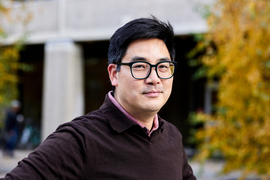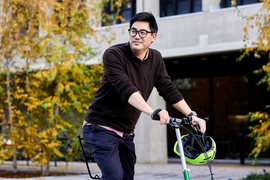A few years ago, David Hsu started taking a keen interest in some apartment buildings in Brooklyn and the Bronx — but not because he was looking for a place to live. Hsu, an associate professor at MIT, works on urban climate change solutions. The property owners were retrofitting their buildings to make them net-zero emitters of carbon dioxide via better insulation, ventilation, and electric heating and appliances. They also wanted to see the effect on interior air quality.
In the process, the owners started working with Hsu and an MIT team to assess the results using top-grade air quality sensors. They found that beyond its climate benefits, retrofitting lowered indoor pollutants from high levels to almost-undetectable levels. It is a win-win outcome.
“Not only are those buildings cleaner and use less energy and do not emit greenhouse gases, they also have better air quality,” Hsu says. “The hopeful thing is that as we remake our buildings for decarbonization, a lot of technologies are so superior that our lives will be better, too.”
Hsu’s projects frequently yield practical, concrete steps for climate action. In New York City, Hsu found, mandating the measurement of energy use lowered consumption 13 to 14 percent over four years. In a 2017 paper, he and his co-authors studied which climate actions would most reduce carbon emissions in 11 major U.S. cities. Cleveland and Denver can greatly reduce use of fossil fuels, for example, while better energy efficiency in new homes would make a big difference in Houston and Phoenix.
“You have to figure out what works and doesn’t work,” Hsu says. “I try to figure out how we can have cleaner and healthier cities that will be more sustainable, equitable, and more just.”
Significantly, Hsu does not just prescribe climate action elsewhere, he also works for change at MIT. He helped create a zero-emissions roadmap for MIT’s School of Architecture and Planning as well as the Department of Urban Studies and Planning, where he is an associate professor of urban and environmental planning and is part of Fast Forward: MIT’s Climate Action Plan for the Decade, serving in the Climate Education Working Group.
“People can get depressed about how you tackle this large, civilization-wide problem, and then you realize lots of other people care about this. Lots of smart people at MIT and other places are working on it, and there are lots of things we can do, individually and collectively,” Hsu says.
And as Hsu’s work shows, lots of people tackle the climate crisis by working on local issues. For his research and teaching, Hsu was granted tenure at MIT this year.
Urban planning by way of Amherst
Hsu studies cities, but is not from one. Growing up in the college town of Amherst, Massachusetts, Hsu could walk out of his home and “be in the woods in a minute.” He attended Yale University as an undergraduate, majoring in physics, and started venturing into New York City with friends. After graduation, Hsu moved there and got a job.
Or three jobs, really. Over the next 10 years, Hsu worked as an engineer, in real estate finance, and for the New York City government as a vice president at the NYC Economic Development Corporation, where he helped manage the city’s post-September 11 redevelopment of the East River waterfront. Eventually, he decided to pursue graduate studies in urban planning, building on his experience.
“Engineering, finance, and government, you put those three things together and they’re basically urban planning,” Hsu says. “It took me a decade after school to realize urban planning is a thing I could do. I say to students, ‘You’re lucky, you have this major. I never had this in college.’”
As a graduate student, Hsu received an MS from Cornell University in applied and engineering physics, then an MSc from the London School of Economics and Political Science in city design and social science, before getting his PhD in urban design and planning at the University of Washington in Seattle. He served on the faculty at the University of Pennsylvania before moving to MIT in 2015.
Hsu studies an array of topics involving local governments and climate policy. He has published multiple papers on Philadelphia’s attempts to refurbish its stormwater infrastructure, for example. His studies about retrofitted apartment buildings are forthcoming as three papers. A 2022 Hsu paper, “Straight out of Cape Cod,” looked at the origins of Community Choice Aggregation, an approach to purchasing clean energy that started in a few Massachusetts communities and now involves 11 percent of the U.S. population.
“I joke that the ideal reader of my articles is not a mayor and it’s not an academic, it’s a midcareer bureaucrat trying to implement a policy,” Hsu says.
Actually, that’s no mere joke. At MIT, City of Cambridge officials have contacted Hsu to discuss his studies of New York and Philadelphia, something he welcomes. Even if not in local government himself, Hsu says, “I know I can do research that might move some of those projects along. It’s my way of trying to contribute to the world outside of academia.”
“It’s all important”
There is still another way Hsu contributes to climate action: by influencing what MIT does. He helped craft the climate policies of the School of Architecture and Planning and the Department of Urban Studies and Planning, which aim to produce net zero emissions for the department through the use of tools like carbon offsets for travel. As part of the Institute-wide Climate Education Working Group convened under the Fast Forward plan, Hsu is busy thinking about how to integrate climate studies into MIT education.
“Our Fast Forward team does great work together. David McGee, Lisa Ghaffari, Kate Trimble, Antje Danielson, Curt Newton, they’re so engaged,” says Hsu. “Our students are terrifically hard-working and skilled and care about climate change, but don’t know how to affect it necessarily. We want to give them on-ramps and skills.”
He is also chair of the fast-growing 11-6 major that combines urban studies and planning with computer science.
“Climate change is happening so fast, and is so big, that every job could be climate-change related,” Hsu says. “If people leave MIT with a higher base understanding of climate change, then you can be a lawyer or consultant or work in finance or computer science and address the unsolved problems.”
Indeed, Hsu thinks many students, who he believes increasingly recognize the severity of climate change, need to prioritize the battle against it when shaping their careers.
“Our fight against climate change is not going to be over by 2050, but 25 years from now, we’re going to know if we transitioned to a net-zero-emitting society for the sake of humanity,” Hsu says. “The students are more aware than ever that climate change is going to dominate their lives. I want students to look back with satisfaction that they helped society.”
More bluntly, he says: “Are you going to say, ‘Oh, I made some money and enhanced my career, but the planet’s going to be destroyed? Or ideally will you find a job that’s satisfying and can support your future hopes for yourself and your family, and also save the planet? Because I think there are a lot of [job] options like that out there.”
Hsu adds, “We’re going to need people pulling in different directions. It’s all important. That’s the message to our students. Go find something you think is important and use your skills. We’re going to need that many people to work on climate change.”












